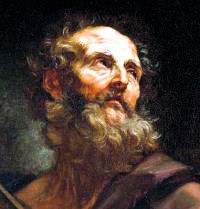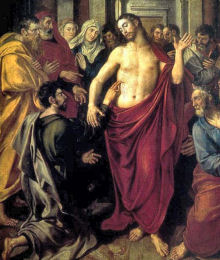
Ordinary Time: July 3rd
Feast of St. Thomas, apostle
Collect: Grant, almighty God, that we may glory in the Feast of the blessed Apostle Thomas, so that we may always be sustained by his intercession and, believing, may have life in the name of Jesus Christ your Son, whom Thomas acknowledged as the Lord. Who lives and reigns with you in the unity of the Holy Spirit, one God, for ever and ever.
o Farina Pudding
o Frumenty Pudding
o Kletzenbrot
o Lamb Pie with Poppy Seed Crust
o Risengroed
o Apostle Cookies
o Family and Friends of Jesus Scrapbook Album
o Namedays
o On Preventing Pride and Vainglory in Children
o What is a Nameday?
o July Devotion: The Precious Blood
o None
» Enjoy our Liturgical Seasons series of e-books!
Old Calendar: St. Irenaeus, bishop and martyr; St. Leo II, pope and confessor (Hist)
St. Thomas, the disciple who at first did not believe, has become for the Church one of the first witnesses to her faith. She is fond of appealing to his testimony and frequently puts in our mouths those simple words whereby he expressed the fervour of his regained faith: "My Lord and my God." It is known that St. Thomas preached the Gospel in Asia beyond the frontiers of the Roman Empire, probably in Persia and possibly as far afield as India. St. Thomas' feast was formerly celebrated on December 21.
According to the 1962 Missal of Bl. John XXIII the Extraordinary Form of the Roman Rite, today is the feast of St. Irenaeus, Doctor of the Church, who wrote many important works of which the most famous is his Adversus Haereses, Against the Heresies, in explanation of the Faith. His feast in the Ordinary Form is celebrated on June 28.
Historically today is the feast of St. Leo II, one of the last Popes of the early Middle Ages. His short pontificate (682-683) was marked by the confirmation of the sixth ecumenical council at which the Monothelite heresy was condemned. St. Leo II also perfected the melodies of the Gregorian chant for the Psalms and composed some new hymns.

St. Thomas
There is very little about the apostle Thomas in the Gospels; one text calls him the "twin." Rarely during Jesus' lifetime does he stand out among his colleagues. There is the instance before the raising of Lazarus, when Jesus was still in Perea and Thomas exclaimed: "Let us also go and die with Him." Best-known is his expression of unbelief after the Savior's death, giving rise to the phrase "doubting Thomas." Nevertheless, the passage describing the incident, had as today's Gospel, must be numbered among the most touching in Sacred Scripture.
In the Breviary lessons Pope St. Gregory the Great makes the following reflections: "Thomas' unbelief has benefited our faith more than the belief of the other disciples; it is because he attained faith through physical touch that we are confirmed in the faith beyond all doubt. Indeed, the Lord permitted the apostle to doubt after the resurrection; but He did not abandon him in doubt. By his doubt and by his touching the sacred wounds the apostle became a witness to the truth of the resurrection. Thomas touched and cried out: My Lord and my God! And Jesus said to him: Because you have seen Me, Thomas, you have believed. Now if Thomas saw and touched the Savior, why did Jesus say: Because you have seen Me, Thomas, you have believed? Because he saw something other than what he believed. For no mortal man can see divinity. Thomas saw the Man Christ and acknowledged His divinity with the words: My Lord and my God. Faith therefore followed upon seeing."
Concerning later events in the apostle's life very meager information exists. The Martyrology has this: "At Calamina (near Madras in India) the martyrdom of the apostle Thomas - he announced the Gospel to the Parthians, and finally came to India. After he had converted numerous tribes to Christianity, he was pierced with lances at the king's command."
Excerpted from The Church's Year of Grace, Pius Parsch
Patron: Against doubt; architects; blind people; builders; construction workers; Ceylon East Indies; geometricians; India; masons; Pakistan; people in doubt; Sri Lanka; stone masons; stonecutters; surveyors; theologians.
Symbols: Spear and lance; carpenter's square and lance; builder's rule; arrows; five wounds of our Lord; girdle; book and spear; spear; t-square.
Often Portrayed As: With a lance (because of his martyrdom) or with a square (because of the legend that he was sent as an architect to the king of India).
Things to Do:
- Much has been written and said about Thomas' weakness of faith. St. Gregory the Great saw God's providential ways: The unbelief of Thomas has benefited us more than the faith of Magdalene. Should we not then reflect on our own failings? So often do we make the firmest resolutions to avoid this or that fault, and yet how easily we repeat it. Give some thought to God's ultimate purpose in permitting your faults and to how valuable for our soul's progress is the realization of our weakness and wretchedness.

St. Leo II
Pope Leo II was a Sicilian. He was learned in sacred and profane letters, as also in the Greek and Latin tongues, and was moreover an excellent musician. He rearranged and improved the music of the sacred hymns and psalms used in the Church. He approved the acts of the sixth General Council, which was held at Constantinople, under the presidency of the legates of the apostolic see, in the presence of the emperor Constantine, the patriarchs of Constantinople and Antioch, and one hundred and seventy bishops: Leo also translated these said acts into Latin.
It was in this Council that Cyrus, Sergius, and Pyrrhus were condemned for teaching that there is in Christ only one will and one operation. Leo broke the pride of the archbishops of Ravenna, who had puffed themselves up, under the power of the exarchs, to set at naught the power of the apostolic see. Wherefore, he decreed that the elections of the clergy of Ravenna should be worth nothing, until they had been confirmed by the authority of the Bishop of Rome.
He was a true father to the poor. Not by money only, but by his deeds, his labours, and his advice, he relieved the poverty and loneliness of widows and orphans. He was leading all to live holy and godly lives, not by mere preaching, but by his own life, when he died in the year 683, he had been Pope eleven months. He was buried in the church of Saint Peter.
Excerpted from The Liturgical Year, Abbot Gueranger O.S.B.
24. But Thomas, one of the twelve, called Didymus, was not with them when Jesus came.
25. The other disciples therefore said to him, We have seen the Lord. But he said to them, Except I shall see in his hands the print of the nails, and put my finger into the print of the nails, and thrust my hand into his side, I will not believe.
CHRYS. A priest though he may have ordered well his own life, yet, if he have not exercised proper vigilance over others, is sent to hell with the evil doers. Wherefore, knowing the greatness of their danger, pay them all respect, even though they be not men of notable goodness. For they who are in rule, should not be judged by those who are under them. And their incorrectness of life will not at all invalidate what they do by commission from God. For not only cannot a priest, but not even angel or archangel, do any thing of themselves; the Father, Son, and Holy Ghost do all. The priest only furnishes the tongue, and the hand. For it were not just that the salvation of those who come to the Sacraments in faith, should be endangered by another's wickedness.
At the assembly of the disciples all were present but Thomas, who probably had not returned from the dispersion: But Thomas, one of the twelve, called Didymus, was not with them when Jesus came.
ALCUIN. Didymus, double or doubtful, because he doubted in believing: Thomas, depth, because with most sure faith he penetrated into the depth of our Lord's divinity.
GREG. It was not an accident that that particular disciple was not present. The Divine mercy ordained that a doubting disciple should, by feeling in his Master the wounds of the flesh heal in us the wounds of unbelief. The unbelief of Thomas is more profitable to our faith, than the belief of the other disciples; for, the touch by which he is brought to believe, confirming our minds in belief, beyond all question.
BEDE. But why does this Evangelist say that Thomas was absent, when Luke writes that two disciples on their return from Emmaus found the eleven assembled? We must understand that Thomas had gone out, and that in the interval of his absence, Jesus came and stood in the midst.
CHRYS. As to believe directly, and any how, is the mark of too easy a mind, so is too much inquiring of a gross one: and this is Thomas's fault. For when the Apostle said, We have seen the Lord, he did not believe, not because he discredited them, but from an idea of the impossibility of the thing itself: The other disciples therefore said to him, We have seen the Lord. But he said to them, Except I shall see in His hands the print of the nails, and put my finger into the print of the nails, and thrust my hand into His side, I will not believe. Being the grossest of all, he required the evidence of the grossest sense, viz. the touch, and would not even believe his eyes: for he does not say only, Except I shall see, but adds, and put my finger into the print of the nails, and thrust my hand into His side.
26. And after eight days again his disciples were within, and Thomas with them: then came Jesus, the doors being shut, and stood in the midst, and said, Peace be to you.
27. Then says he to Thomas, Reach hither your finger, and behold my hands; and reach hither your hand, and thrust it into my side: and be not faithless, but believing.
28. And Thomas answered and said to him, My Lord and My God.
29. Jesus says to him, Thomas, because you have seen me, you have believed: blessed are they that have not seen, and yet have believed.
CHRYS. Consider the mercy of the Lord, how for the sake; of one soul, He exhibits His wounds. And yet the disciples deserved credit, and He had Himself foretold the event. Notwithstanding, because one person, Thomas, would examine Him, Christ allowed him. But He did not appear to him immediately, but waited till the eighth day, in order that the admonition being given in the presence of the disciples, might kindle in him greater desire, and strengthen his faith for the future. And after eight days again His disciples were within, and Thomas with them: then came Jesus, the doors being shut, and stood in the midst, and said, Peace be to you.
AUG. You ask; If He entered by the shut door, where is the nature of His body? And I reply; If He walked on the sea, where is the weight of His body? The Lord did that as the Lord; and did He, after His resurrection, cease to be the Lord?
CHRYS Jesus then comes Himself, and does not wait till Thomas interrogates Him. But to show that He heard what Thomas said to the disciples, He uses the same words. And first He rebukes him; Then says He to Thomas, Reach hither your finger, and behold My hands; and reach hither your hand, and thrust it into My side: secondly, He admonishes him; And be not faithless, but believing. Note how that before they receive the Holy Ghost faith wavers, but afterward is firm. We may wonder how an incorruptible body could retain the marks of the nails. But it was done in condescension; in order that they might be sure that it was the very person Who was crucified.
AUG. He might, had He pleased, have wiped all spot and trace of wound from His glorified body; but He had reasons for retaining them. He showed them to Thomas, who would not believe except he saw and touched, and He will show them to His enemies, not to say, as He did to Thomas, Because you have seen, you have believed, but to convict them: Behold the Man whom you crucified, see the wounds which you inflicted, recognize the side which you pierced, that it was by you, and for you, that it was opened, and yet you cannot enter there.
AUG. We are, as I know not how, afflicted with such love for the blessed martyrs, that we would wish in that kingdom to see on their bodies the marks of those wounds which they have borne for Christ's sake. And perhaps we shall see them; for they will not have deformity, but dignity, and, though on the body, shine forth not with bodily, but with spiritual beauty. Nor yet, if any of the limbs of martyrs have been cut off, shall they therefore appear without them in the resurrection of the dead; for it is said, There shall not an hair of your head perish. But if it be fit that in that new world, the traces of glorious wounds should still be preserved on the immortal flesh, in the places where the limbs were cut off there, though those same limbs withal be not lost but restored, shall the wounds appear. For though all the blemishes of the body shall then be no more, yet the evidences of virtue are not to be called blemishes.
GREG. Our Lord gave that flesh to be touched which He had introduced through shut doors: wherein two wonderful, and, according to human reason, contradictory things appear, viz. that after the resurrection He had a body incorruptible, and yet palpable. For that which is palpable must be corruptible, and that which is incorruptible must be impalpable. But He showed Himself incorruptible and yet palpable, to prove that His body after His resurrection was the same in nature as before, but different in glory.
GREG. Our body also in that resurrection to glory will be subtle by means of the action of the Spirit, but palpable by its true nature, not, as Eutychius says, impalpable, and subtler than the winds and the air.
AUG. Thomas saw and touched the man, and confessed the. God whom he neither saw nor touched. By means of the one he believed the other undoubtingly: Thomas answered and said to Him, My Lord and My God.
THEOPHYL. He who had been before unbelieving, after touching the body showed himself the best divine; for he asserted the twofold nature and one Person of Christ; by saying, My Lord, the human nature by saying, My God, the divine, and by joining them both, confessed that one and the same Person was Lord and God.
Jesus says to him, Because you have seen Me, you have believed.
AUG. He says not, has touched me, but, has seen me; the sight being a kind of general sense, and put in the place often of the other four senses; as when we say, Hear, and see how well it sounds; smell, and see how sweet it smells; taste, and see how well it tastes, touch, and see how warm it is. Wherefore also our Lord says, Reach hither your finger, and behold My hands. What is this but, Touch and see? And yet he had not eyes in his finger. He refers them both to seeing and to touching, when He says, Because you have seen, you have believed. Although it might be said, that the disciple did not dare to touch, what was offered to be touched.
GREG. But when the Apostle says, Faith is the substance of things hoped for, the evidence of things not seen, it is plain that things which are seen, are objects not of faith, but of knowledge. Why then is it said to Thomas who saw and touched, Because you have seen Me, you have believed? Because he saw one thing, believed another; saw the man, confessed the God. But what follows is very gladdening; Blessed are they that have not seen, and yet have believed. In which sentence we are specially included, who have not seen Him with the eye, but retain Him in the mind, provided we only develop our faith in good works. For he only really believes, who practices what he believes.
AUG. He uses the past tense, in the future to His knowledge having already taken place by His own predestination.
CHRYS. If any one then says, Would that I had lived in those times, and seen Christ doing miracles! let him reflect, Blessed are they that have not seen, and yet have believed.
THEOPHYL. Here He means the disciples who had believed without seeing the print of the nails, and His side.
Catena Aurea John 20




